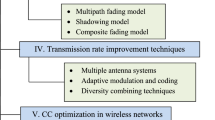Abstract
In this paper, we propose two adaptive cooperation protocols for wireless systems. The first protocol chooses between cooperative communications (CC) and non-cooperative communications (NCC), the protocol that offers the highest instantaneous throughput. The best relay is activated only if the instantaneous throughput of relayed link is larger than that of direct link. The second protocol chooses between CC and NCC, the protocol that maximizes the average throughput. The best relay amplifies the received signal only when the average throughput of relayed link is larger than that of direct link. Both protocols include adaptive modulation and coding to increase the throughput by selecting the appropriate modulation and coding scheme. The results are valid for Rayleigh fading channels where relay nodes use amplify and forward relaying.







Similar content being viewed by others
References
Liu, Q., Zhou, S., Giannakis, G.B.: Cross-layer combining of adaptive modulation and coding with truncated ARQ over wireless links. IEEE Trans. Wirel. Commun. 3(5), 1746–1755 (2004)
Goldsmith, A.J., Chua, S.-G.: Adaptive coded modulation for fading channels. IEEE Trans. Commun. 46(5), 595–602 (1998)
Liu, Q., Zhou, S., Giannakis, G.B.: Queuing with adaptive modulation and coding over wireless links: cross-layer analysis and design. IEEE Trans. Wirel. Commun. 4(3), 1142–1153 (2005)
Catreux, S., Erceg, V., Gesbert, D., Heath, R.W.: Adaptive modulation and MIMO coding for broadband wireless data networks. IEEE Commun. Mag. 40(6), 108–115 (2002)
Hole, K.J., Holm, H., Oien, G.E.: Adaptive multidimensional coded modulation over flat fading channels. IEEE J. Sel. Areas Commun. 18(7), 1153–1158 (2000)
Oien, G.E., Holm, H., Hole, K.J.: Impact of channel prediction on adaptive coded modulation performance in Rayleigh fading. IEEE Trans. Veh. Technol. 53(3), 758–769 (2004)
Wang, X., Liu, Q., Giannakis, G.B.: Analyzing and optimizing adaptive modulation coding jointly with ARQ for QoS-guaranteed traffic. IEEE Trans. Veh. Technol. 56(2), 710–720 (2007)
Koike-Akino, T., Kojima, K., Millar, D., Parsons, K., Yoshida, T., Sugihara, T.: Pareto optimization of adaptive modulation and coding set in nonlinear fiber-optic systems. J. Lightw. Technol. PP(99), 1 (2016)
López-Benítez, M.: Throughput performance models for adaptive modulation and coding under fading channels. In: 2016 IEEE Wireless Communications and Networking Conference, pp. 1–6 (2016)
Zhao, Y., Chen, Z., Ji, H.: Moore state machine for adaptive modulation and coding in high-speed railway LTE-R systems. Electron. Lett. 52(9), 776–778 (2016)
Zhang, Y., Shen, Y., Zhang, Z., You, X., Zhang, C.: Adaptive spatial modulation combining BCH coding and Huffman coding Tong Xue. In: 2018 IEEE 23rd International Conference on Digital Signal Processing (DSP), pp. 1–5 (2018)
Zeng, R., Liu, T., Yu, X., Zhang, Z.: Novel channel quality indicator prediction scheme for adaptive modulation and coding in high mobility novel channel quality indicator prediction scheme for adaptive modulation and coding in high mobility environments. IEEE Access 7, 11543–11553 (2019)
Azza, M.A., El Yahyaoui, M., El Moussati, A.: Throughput performance of adaptive modulation and coding schemes for WPAN transceiver. In: International Symposium on Advanced Electrical and Communication Technologies (ISAECT), pp. 1–4 (2018)
Muhammad, R., Shikh-Bahaei, M.: Cross-layer combining of truncated ARQ with adaptive modulation and coding in full duplex systems. In: Wireless Advanced (WiAd), pp. 1–6 (2018)
Jiao, W., Ding, H., Wu, H., Yu, G.: Spectrum efficiency of jointing adaptive modulation coding and truncated ARQ with QoS constraints. IEEE Access 6, 46915–46925 (2018)
Shi, F., Yuan, D.: Cross-layer combination of cooperative HARQ with AMC in wireless ad-hoc networks. In: 11th IEEE Singapore International Conference on Communication Systems, pp. 896–900 (2008)
Sunu, C., Aktas, E.: Adaptive modulation and coding (AMC) in cooperative communication channels. In: 22nd Signal Processing and Communications Applications Conference (SIU), pp. 1571–1574 (2014)
Wang, N., Gulliver, A.T.: Packet level analysis for AMC in a wireless cooperative communication system over Nakagami-m fading channels. In: 12th Canadian Workshop on Information Theory, pp. 130–133 (2011)
Harsini, J.S., Farshad, L., Levorato, M., Zorzi, M.: Analysis of non-cooperative and cooperative type II hybrid ARQ protocols with AMC over correlated fading channels. IEEE Trans. Wirel. Commun. 10(3), 877–889 (2011)
Wang, N., Gulliver, T.A.: Cross layer AMC scheduling for a cooperative wireless communication system over Nakagami-m fading channels. IEEE Trans. Wirel. Commun. 11(6), 2330–2341 (2012)
Ramis, J., Femenias, G.: Cross-layer modeling of wireless systems using AMC with cooperative-ARQ error control. In: European Wireless Conference, pp. 1–8 (2012)
Markovic, G.B. Dukic, M.L.: The applicability of cooperative AMC with multiple sensors in dispersive fading channels. In: 2013 21st Telecommunications Forum Telfor (TELFOR), pp. 224–227 (2013)
Bapatla, D., Prakriya, S.: Performance of incremental relaying with an energy-buffer aided relay. In: 2019 IEEE 89th Vehicular Technology Conference (VTC2019-Spring)
Bapatla, D., Prakriya, S.: Performance of energy-buffer aided incremental relaying in cooperative networks. IEEE Trans. Wirel. Commun. 18(7), 3583–3598 (2019)
Liu, D., Zhao, M., Zhou, W.: Energy efficiency optimization in energy harvesting incremental relay system. In: 2018 10th International Conference on Wireless Communications and Signal Processing (WCSP) (2018)
Li, G., Mishra, D., Jiang, H.: Cooperative NOMA with incremental relaying: performance analysis and optimization. IEEE Trans. Veh. Technol. 67(11), 11291–11295 (2018)
Boddapati, H.K., Bhatnagar, M.R., Prakriya, S.: Performance of incremental relaying protocols for cooperative multihop CRNs. IEEE Trans Veh. Technol. 67(7), 6006–6022 (2018)
Proakis, J.: Digital Communications, 5th edn. MacGraw-Hill, London (2007)
Hasna, M.O., Alouini, M.S.: Outage probability of multihop transmission over Nakagami fading channels. IEEE Commun. Lett. 7(5), 216–218 (2003)
Anghel, P.A., Kaveh, M.: Exact symbol error probability of a cooperative network in a Rayleigh fading environnement. IEEE Trans. Wirel. Commun. 3(5), 1416–1421 (2004)
Author information
Authors and Affiliations
Corresponding author
Additional information
Publisher's Note
Springer Nature remains neutral with regard to jurisdictional claims in published maps and institutional affiliations.
Rights and permissions
About this article
Cite this article
Ben Halima, N., Boujemâa, H. Adaptive cooperation protocol with adaptive modulation and coding. SIViP 15, 323–329 (2021). https://doi.org/10.1007/s11760-020-01757-6
Received:
Revised:
Accepted:
Published:
Issue Date:
DOI: https://doi.org/10.1007/s11760-020-01757-6




